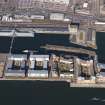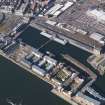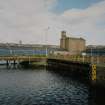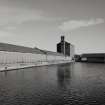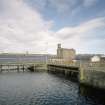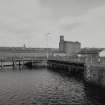Dundee, Camperdown Street, Victoria Dock, Harbour Warehouse
Warehouse (Period Unassigned)
Site Name Dundee, Camperdown Street, Victoria Dock, Harbour Warehouse
Classification Warehouse (Period Unassigned)
Alternative Name(s) Dundee Harbour; Clock Warehouse; Port Of Dundee; River Tay; Firth Of Tay
Canmore ID 237997
Site Number NO43SW 89.07
NGR NO 41113 30533
Datum OSGB36 - NGR
Permalink http://canmore.org.uk/site/237997
- Council Dundee, City Of
- Parish Dundee (Dundee, City Of)
- Former Region Tayside
- Former District City Of Dundee
- Former County Angus
NO43SW 89.07 41113 30533
Field Visit (April 2004 - April 2007)
Dundee, Victoria Dock, Harbour (clock) warehouse
2009
This 5 storey and attic (with six level clock tower), 1 bay by 5 bay, ashlar, fireproof bonded warehouse and granary in the Italianate style dates from 1877. (1) It was designed by the engineer David Cunningham who was Dundee Harbour Engineer until about 1890. (2)
The exterior N and S facades bays 1, 3 and 5 have tripartite windows on each of floors 1-4, with the 4th floor windows within arched recesses. Bays 2 and 4 (hoist bays) have wide arches at the 4th floor level. These originally wooden hoist doors have been removed and the openings blocked with brick in the last 60 years.
The ground floor is blind and housed the bonded warehouse with its two 4.4m high by 3.5m wide, arched doorways (see DC51302). These provided access from the quayside as well as onto the North British Railway sidings which served the Victoria and Camperdown Docks and shipyards to the east. (3)
Interior
The fireproof interior is rather fine. Each floor has cast iron columns and brick-arched ceilings with wrought-iron ties (see DP018430) with a span of 3.3m.The concrete skin over the top of the arches of the floor below are 0.22m in thickness. The depth of the arch is some 0.4m. The beams are of the bowed Hodgkinson design (the ‘I’ beam originally perfected by Eaton Hodgkinson in 1830, that is a beam with a vertical web and two horizontal flanges, see DP018428, SC1047300 ). (4) It would appear that floors 2, 3 and 4 were used to store grain as the cast iron columns on each of these floors have integral cast grooves to take the dividing boards between each grain bin (see DC51304, DP018429, DP018431and SC1047300). The attic area (5th floor) contains a mezzanine floor with wrought-iron beams and strut roof support (see DC51302, SC1047302 and DP018432).
The lift was built before 1943, and was presumably inserted when the building was converted to a bonded warehouse (see SC1128965). The lift shaft is constructed in corrugated iron but was not accessible due to severe pigeon infestation. There are sliding fire doors at each level as added security and as prevention against fire resulting from grain dust explosions.
Multi storey dock warehouses are now rare in Scotland. This example is not as old as the old bonded warehouses fronting onto John Rennie’s West and East Docks, Commercial Street, Leith, Edinburgh (1800-1806; 1820; NT27NE 1458) but is earlier than James Watt Dock Sugar Warehouse, Greenock (about 1885).
(1) McKean, C. and Walker, D, Dundee, an illustrated architectural guide (RIAS, 1993), 30)
(2) (http://www.scottisharchitects.org.uk/architect_full.php?id=202395, retrieved 8 December 2009).
(3) Ordnance Survey, 2nd edition one inch to the mile map, sheet 49 (Arbroath), 1896
(4) http://encyclopedia.stateuniversity.com/pages/6310/Eaton-Hodgkinson.html, retrieved 8 December 2009.
Visited by RCAHMS(MMcD), 2004 and April 2007.























































